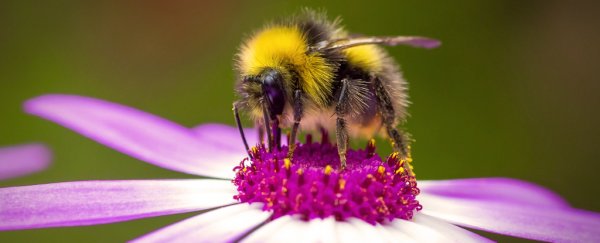The world's favorite herbicide is making it harder for buff-tailed bumblebees to keep their hives warm enough to incubate larvae, new research finds.
Bumblebees (Bombus terrestris) face food shortages due to habitat loss and the widespread monocultures of agricultural crops. Like honeybees, they feed on nectar collected from plants, and store more of it in their nest. They also gather nectar and pollen to feed their young.
Bumblebees are unique in their ability to maintain a collective 'thermostat' of sorts, to keep warm in areas where other bees cannot; they do this by regulating their own body temperature and the colony's heat by 'shivering'.
This makes them important pollinators in cooler areas, and is essential for developing larvae, which can only reach adulthood if their brood is kept between 25 and 35°C.
When food is in short supply, the colony cools down, and larval development can be affected. But a new study published in Science has found that resource depletion is not the only thing messing with the bees' incubation.
Glyphosate is used by farmers and gardeners alike, to kill weeds and regulate crops. The chemical inhibits an enzyme present only in plants, fungi, and some bacteria, and so it was long thought to be harmless to bees.
However, this study is the latest of many recent reports on the nonlethal – but undoubtedly harmful – effects of glyphosate on bees.
To get a clear picture of how this chemical affects bumblebees, researchers at the University of Konstanz kept 15 bumblebee colonies in a lab.
Each colony was divided into two sections by a wire mesh, with equal numbers of worker bees on each side. On one side, workers were given ordinary sugar water and pollen. The other side was fed the same – except their sugar water was spiked with 5 mg/L of glyphosate.
The workers could see and touch each other through the mesh, but because bumblebees do not exchange liquid food like honeybees do, cross-contamination was not a concern.
To avoid bias, researchers feeding the bees were not told which side of the colony was being given the herbicide-laced liquid until all data were collected.
Firstly, they wanted to find out if individual bees would be affected by glyphosate exposure.
They isolated workers from both sides of each colony and gave each bee a 'brood dummy': an imitation larva covered with wax from previous broods, that the bees care for as if it were real.
Regardless of whether the bees had been fed with glyphosate-laden or ordinary sugar water, they set about tending to their dummy, and although individual bees exposed to herbicide were slightly more sluggish in their incubation duties, the results of this experiment were statistically weak.
But of course, as social animals, bees really need to be observed as a colony to see the full effects of any stressor. This is why the scientists proceeded to look at thermal ability "at the colony level" – this is where they found significant differences.
On each side of a colony, the researchers recorded temperature data in two sections of a brood: one with pupae, and one with larvae.
Thirty days after the colonies were divided and half of each put on a diet of glyphosate-tainted sugar water, the scientists limited their food resources and began to measure the changes in brood temperature on both sides of the nests.
"When colonies were undisturbed and well-fed," the authors wrote, "no difference in mean nest temperature between the two sides of a colony was detected."
"However, when colonies experience resource limitation, effects of glyphosate exposure became evident."
When their food supply was reduced, the nests that had not been exposed to glyphosate cooled down, but not below the optimum range for larval development.
But on the other side of the mesh, where the same resource limitation was paired with glyphosate exposure, temperatures dropped much faster, eventually dipping below the optimal range for growing young bumblebees.
In the wild, this phenomenon could reduce breeding rates in periods of food scarcity, and contribute to a further decline of bumblebees worldwide.
Since bumblebees are important pollinators – and, in lab research, are considered surrogates for how other wild bee species might be affected – the findings of this study are both illuminating and alarming.
It's still unclear exactly why glyphosate affected the bumblebees observed, but based on previous research, the scientists suspect it may be due to the impacts of glyphosate on the bees' microbiome.
Regardless of the underlying chemical effects, the study raises concerns about the "subtle, nonlethal" effects of a herbicide once thought to be harmless.
This research was published in Science.
